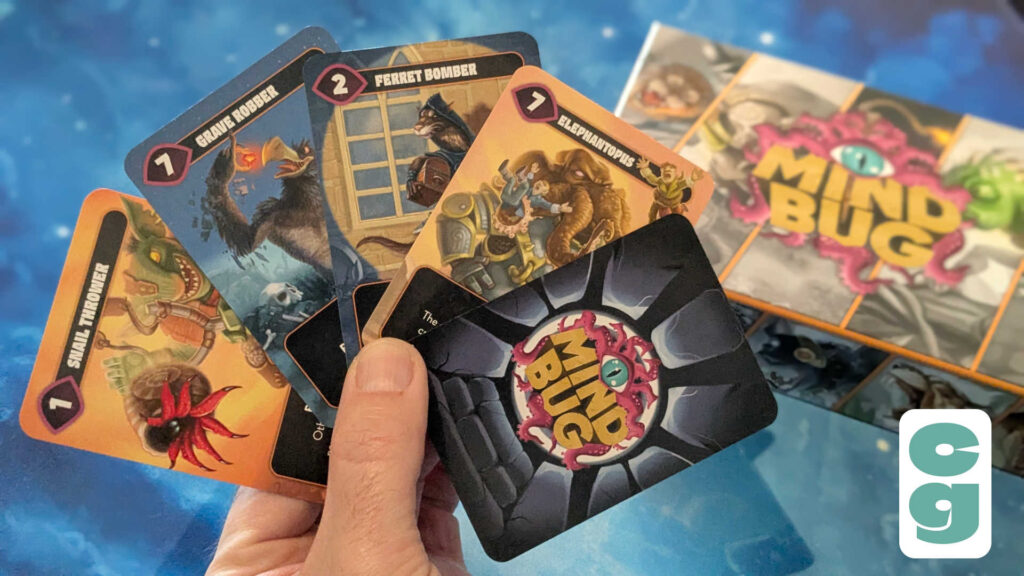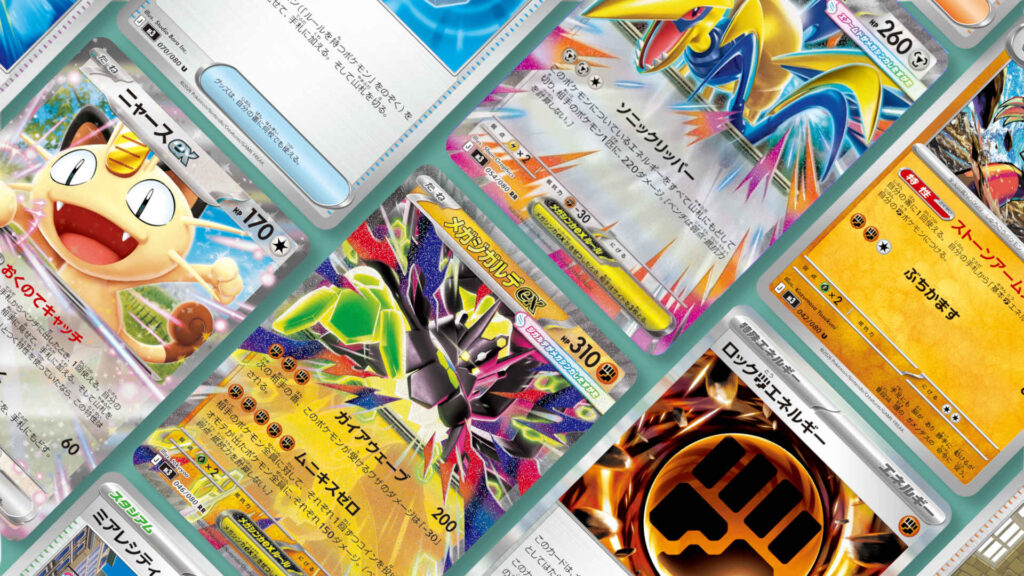Released in 2022, Mindbug (also known as Mindbug: First Contact), is a game of creature combat, featuring bizarre hybrids alongside the eponymous alien beings, the latter of which allow you to take control of your opponent’s beasts. It’s co-designed by Richard Garfield (the creator of Magic: The Gathering), along with Skaff Elias, Marvin Hegen, and Christian Kudahl.
Is Mindbug worth breaking out of containment, to be set loose on your gaming table? Let’s find out!Table of Contents
ToggleGetting Started With Mindbug

There are various Mindbug products available; each of the boxed expansions is a standalone game in its own right. We’d recommend getting hold of the initial Mindbug game if you haven’t played before, as the keywords and mechanics which arise from their use are the easiest to grasp in the original title.
Which means you’ll just need Mindbug itself to get started. A two-player game (though it’s possible to play with more, with variant rules), Mindbug is surprisingly compact and almost minimalist in terms of its components; each player will be dealt just 10 cards (from a deck of 48) for each game, and will also have access to two Mindbug cards each. Players don’t have their own deck to be dealt cards from, and there’s no deck construction – so prep time is non-existent. Just deal each player their 10 cards from the shared deck, they draw five each from their dealt cards, set their life spinner dial to 3, and then play can begin.
How to Play Mindbug

Just as the components are minimal, so too is the general order of play. On a turn, you have two choices: play a creature, or attack with one of the creatures you already have in play.
Playing a Creature
If you play a creature, your opponent gets the opportunity to play one of their two Mindbugs (flipping the card over if they do so, in order to show that it’s been used) to take immediate control of the newly played creature (you can see the Mindbug cards above, along with their corresponding life spinners). Playing the Mindbug will grant the active player an immediate extra turn, so they don’t miss out.
With no cost to play any cards, you’re free to play the most powerful card in your hand on turn one. Of course, your opponent’s Mindbugs serve as a way to balance this, so careful timing and some bluffing is useful when your opponent still has at least one Mindbug available to use! As soon as you play a card, you draw back up to five; if you have no cards left to draw from (from your initial deck of 10 cards), you simply continue playing without drawing.
Attacking
If you attack, you declare an attacker from the creatures you have in play, then the opponent decides whether or not to block. If your opponent doesn’t block, they remove one life point from their total. If a player goes down to zero life points, the attacker wins the game, so it’s usually in their best interest to block any incoming damage.

If they block, they announce which of their creatures is blocking, and then the combat begins. Whichever creature has the highest power wins, and the loser is defeated (meaning that they’re removed from the play area and discarded). In the above example, if the Luchataur attacked, the Tiger Squirrel can block, but it’ll be defeated as the Luchataur has nine power, and the Tiger Squirrel only has three. However, if the Tiger Squirrel was attacking, the Luchataur could not block, as the Tiger Squirrel has the Sneaky keyword.

Sneaky is one of the card keywords and abilities which add an extra dimension, and many different strategic considerations, to the equation; here are the five keywords featured in the base set of Mindbug (shown on cards above).
- Frenzy – A creature with Frenzy can (if they survive the first attack attempt) attack again immediately.
- Poisonous – This creature will defeat the blocker, even if it loses the battle.
- Tough – Creatures with Tough are able to take an extra hit, and rotate sideways when they take their first damage, only being defeated if they’re hit again.
- Sneaky – Creatures with Sneaky can only be blocked by other Sneaky creatures.
- Hunter – Creatures with the Hunter keyword can choose a creature who’s forced to block the Hunter’s attack.

Additionally, timed abilities trigger at specific moments during a turn. Attack, for example, is carried out when a creature is used to attack. Defeated when a creature is (yes, you guessed it!) defeated in an attack. Finally, Play abilities are triggered as soon as a card is played, but if the card has been controlled by a Mindbug, the opposing player (who played the Mindbug) gets to carry this ability out as if they played the card.
Is Mindbug Fun to Play?
As a two-player game, Mindbug is a surprisingly deep experience, especially given its somewhat minimalistic approach. There are just five different keywords in the game, but the impressive array of strange, beautifully designed and gorgeously illustrated creatures also have various abilities that can be utilized during games, with some brilliantly clever plays possible because of this. The artwork on each card really is fantastic, and considering the lack of overall text or lore in Mindbug, the cards have an awful lot of character and charm, not to mention a great deal of wit in the creature names.
The method of dealing 10 cards to each player from a larger, shared deck means that you’re never quite sure what cards your opponent has, and knowing when to play Mindbugs, given that you only have two each, becomes a really important and compelling element of the game.

It also plays really quickly; with no energy or resource cost to take into consideration, a game of Mindbug can often feel as if it kicks off at top speed, rather than steadily accelerating, as would be the case in games where a row of energy or resource cards will be built over the course of several turns. This also means that games tend to take no longer than 10 or 15 minutes, yet feel packed with interesting, sometimes agonizing, decisions on every turn, and the variables possible with different card combinations turn the agony over what to do, and when, into a very exciting aspect of each game, from beginning to end.
Though there are just 48 cards in a Mindbug deck, and deck building isn’t possible at this stage, the game really does have the feel of an incredibly fast paced and easy to learn Trading Card Game (also known as a TCG). This makes it the perfect game to teach newcomers who may not be overly familiar with TCGs, with numerous concepts and gameplay elements which will be very familiar to TCG veterans, but won’t overwhelm absolute beginners.
The Card Gamer Verdict
I have no hesitation in recommending Mindbug as being up there with the very best two-player card games I’ve ever played. Though it has the feel of much larger and more complex games such as Magic: The Gathering, it’s a far more accessible and beginner friendly experience, yet still has plenty of depth and lots of interesting decisions to be made on every turn.
The creature design and artwork in general is absolutely fantastic, with a great deal of wit and charm sprinkled throughout the cards and the game’s overall aesthetic.
With numerous expansions and promo cards available for Mindbug, if players do want to add more variety, or slightly more complexity in the keywords, it’s pretty straightforward, and also cost effective, to do so.
As Mindbug itself is a compact and reasonably priced game, as are its expansions, it’s also fantastic value for money, packing a huge amount of gameplay into its compact box and minimal components; all of this goes to show exactly why Mindbug is one of the very best two-player, non-collectible card games we’ve played in quite some time.
Want to take a look at other two-player, non-collectible card games? Read our reviews of Gloom, Star Wars: The Deckbuilding Game – Clone Wars Edition, and Jaipur.





